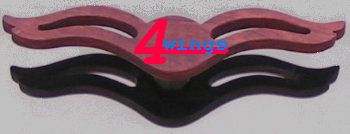|
ENGINE SUBSYSTEMS
LUBRICATION SUBSYSTEM:
Lubrication of moving parts is as
crucial for this engine as a reciprocating engine. However, even in the
case of lubrication subsystem failure the failure mode is gradually,
with the engine actually slowing down to a stop as the friction
increases rather than suddenly sizing as piston engines are inclined to
do.
The internal design does require oil
to be injected into the rotor chamber for lubrication. In automotive
use the engine draws on oil from the crankcase for this purpose. A
closer look at the system is available
here.
This is not a desirable feature for
hovercraft usage in that it can result in exhaustion of lubricating oil
in the crankcase, if not frequently checked, and the carbon deposits
from combustion of automobile engine oil causes internal wear of the
seals of the rotors.
Some alternatives to the above system
are :
- Eliminate the crankcase oil
injection subsystem and instead mix 2 cycle oil in the gasoline. This
has proven to be a reliable method and removes the possibility of
crankcase oil exhaustion and improves the rotor seal life. It does,
however, require mixing the 2 cycle oil with each gasoline fill
up.
- Install a metering pump
adapter, as offered by PCV Technologies which takes the solution one step further in allowing to
still using the stock metering pump but supply it with two-stroke oil.
Heat ejection by the lubrication
subsystem is crucial for maintaining engine temperature within design
limits. This is accomplished through an oil cooler with a fin surface
equal to that used in the automobile application. Most aluminum oil
cooler as used in race car applications will provide this job.
Lubrication Subsystem
Instrumentation:
The lubrication subsystem can
be instrumented with an oil pressure and oil temperature gauge
mounted in the instrument panel.
A dipstick provides for oil quantity
measurement.
ELECTRICAL/IGNITION
SUBSYSTEM:
Additional features relative to safety is that each
rotor chamber has two spark plugs with two independent ignition coils
for each plug set. There is one plug per rotor chamber referred to as
the "Lead" and one referred to as the "Trailing" plug. The trailing
plug in the automobile application is set to fire approximately 15
degrees after the lead plug fires. The engine will run on just the
trailing plug setting for auto application, however, there is
considerable power loss. While the trailing plug
was designed principally to meet auto emission and fuel economy
standards, it can be recalibrated to fire essentially in sync with the
lead plug providing true redundant ignition for the engine in
Hovercraft application. An after market ignition computer can be
used which provides two independent ignition CPUs and a feature for
checking each ignition coil subsystem independently.
The electric charging is accomplished with 12 volt
marine alternator ( single wire to high amp unit ) with internal
voltage regulator.
Electrical Subsystem
Instrumentation:
The electrical subsystem can be instrumented with a High/Low
voltage visual indicator as well as a voltmeter which can be switched.
COOLING SUBSYSTEM:
Since the engine is liquid cooled the
adverse effects of "shock" cooling which can cause cylinder damage on
air cooled engines does not occur. Again, a positive feature. Due to
the fact that this small displacement engine does produce so much power
relative to its displacement, adequate cooling is a critical need to
remove the excess heat from the block. Approx. 1/3 of the heat
rejection (above that not ejected by the exhaust gases) is by the
lubrication system through an oil cooler. The remaining (approx. 2/3 of
the waste heat) is ejected through a water based
coolant system using radiators
installed in the thrust duct exit section of the craft or any location
where adequate airflow is possible.
Additionally, since the engine is
liquid cooled, cabin heat can be derived from an heat exchanger
in the cockpit to transfer heat from the coolant system into the
cockpit. The heat exchanger can have a manual coolant cutoff
valve as well as a manually controlled fan. This approach removes the
danger of carbon monoxide leaking into the cabin through the typical
exhaust muff approach to heating .
Coolant Subsystem
Instrumentation:
The coolant system can be
instrumented with both a coolant temperature gage and a coolant
pressure gage.
The coolant pressure gage will
immediately indicate any abnormality and provide early warning of a
leak giving time for a flight to be terminated before complete loss of
coolant.
If only a coolant temperature gage
were used, considerable loss of coolant is possible before a rise in
temperature would indicate a problem existed. Therefore, the coolant
pressure gage is considered a crucial feature of any liquid coolant
system in an Hovercraft.
PROPELLER SPEED REDUCTION UNIT
(PSRU):
A PSRU is used to reduce the engine RPM to that required
for efficient and safe propeller / fan operation.
The PSRU is provided by "GoodYear" orange eagle PD belts ( w=700mm)in a
ratio 2:1 .
Alternative a Ross Aero PSRU designed for the Mazda 13B using
planetary gears providing a 2.17:1 reduction.
FUEL SUBSYSTEM:
The fuel subsystem in our case is adjusted to a carburated engine. It
consist of a marine fuel pump, inlet filter, outlet filter and fuel
pressure regulator with return line. All fuel lines consist of
USCG compliant hoses. The fuel system was pressurized with
air to test for leaks.
For a more detailed file please see : fuel system on
high speed Hovercraft
SUMMARY
In summary, I believe the engine has a number of
inherently desirable features and benefits for hovercraft use.
The adaptations to make it suitable for hovercraft use have been
carefully thought out and failure modes thoroughly examined.
4wings Main page
- 4wings Yachtservice - Kite-sailer.com - Site-map
|

